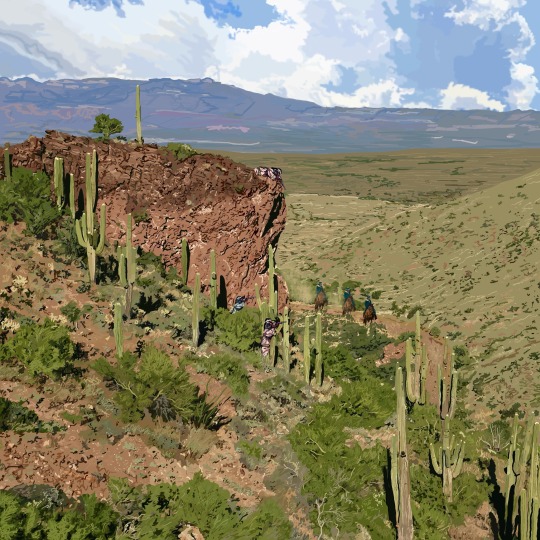#The Apache
Explore tagged Tumblr posts
Text

This is the fifth episode in the series over the Apache Indians in the American Southwest. This episode covers the aftermath of the Camp Grant Massacre and encompasses the years 1870 to 1874. It also continues the story of the most feared Apache warrior chief to have ever lived in the eyes of the Americans: Cochise.
The episode introduces important men of history in the region like General Crook, General Howard, Captain Tom Jeffords, Cochise’s sons Taza and Naiche, the Tonto Apache chief Red Ant (Delshay), the various Apache Scout leaders like Al Sieber, and countless others. Lieutenant Bourke, Geronimo, Merejildo Grijalva, and Mickey Free the kidnapped boy who started this long war also make heavy return appearances. The massive offensive against the Apaches and Yavapai Indians during the winter of 1872 to 1873 is discussed in detail as well as the flip side of the Indians Wars: President Grant’s “Peace Policy”.
Battles ensue, bureaucrats meddle, reservations are established, massacres like the Skeleton Cave Massacre blight the land, but by the end of the episode peace will reign, however briefly, on Apacheria.
38 notes
·
View notes
Text










The Apache say "Don't aim with your eyes, aim with your heart." Of course, the Chippewa say "Aim with your eyes." And they won the war, so...
The Afterparty - Season 2, Episode 4 Hannah Created by Christopher Miller
Blackram Hall: whodunit, murder mystery, hardboiled, pulp, crime, thriller, italian giallo, noir and neo-noir, detectives and serial killers, spy stories, vintage, manor houses, art, life and death.
#Chris Miller#Christopher Miller#the Afterparty#detective stories#murder mystery#Sam Richardson#Tiffany Haddish#Zoë Chao#Elizabeth Perkins#Zach Woods#Paul Walter Hauser#Poppy Liu#Anna Konkle#Jack Whitehall#Vivian Wu#John Cho#Ken Jeong#apple tv+#The Apache#The Ojibway#Wes Anderson
28 notes
·
View notes
Text

#Apache#Apache Warrior#the Apache#deadliest warrior#spike tv#could infinity train have saved them poll#could infinity train have saved them
2 notes
·
View notes
Text
Learn Something New about the Vietnam War
I’ve collected five Informational videos about the war in Vietnam. Grab a coffee, sit back, and take a chance to discover something you might not have known about those fighting 10,000 miles away in Vietnam, The Republic of. This video talks about three different jungle wars…Vietnam is only the first portion. You can choose to stop watching afterward. ***** Thank you for taking the time to…

View On WordPress
#A Vietnam War Story#books war#cherry soldier#Combat Infantry#digital books#firefights#jungle warfare#The Apache#tunnel rats#Vietnam blog pages#Vietnam conflict#war books#White Feather#Women in war
1 note
·
View note
Text

965 notes
·
View notes
Text

AH-64 Apache
724 notes
·
View notes
Text
♦️🔸️💎🔸️♦️🔹️💎🔹️♦️🔸️💎🔸️♦️
🔸️ Would or Wouldn't ❓️ 🤔
1959 Chevrolet 3100 Apache Pickup

#1959#1950s#Chevrolet#chevy#apache#pickup#chevrolet pickup#classic cars#vintage cars#classic car#car show#luxury cars#autos#fast cars#sports cars#cars#vintage car#green
528 notes
·
View notes
Text




1958 Chevrolet Apache Cameo Carrier
My tumblr blogs:
www.tumblr.com/germancarssince1946 & www.tumblr.com/frenchcarssince1946 & www.tumblr.com/englishcarssince1946 & www.tumblr.com/italiancarssince1946 & www.tumblr.com/japanesecarssince1947 & www.tumblr.com/uscarssince1935 & www.tumblr.com/swedishcarssince1946
226 notes
·
View notes
Text

i thought i should join this tend i had fun with this drawing uwu
#digital art#artists on tumblr#native american#indigenous art#native artist#native miku#hatsune miku#miku fanart#apache tribe#indigenous miku#miku worldwide
554 notes
·
View notes
Text
Oct 7th was an act of resistance and occupiers who hold raves outside a concentration camp deserve a fate worse than death.
Glory to the resistance 🔻
#all day every day#from the river to the sea#this is also the anniversary of when the IDF used apache helicopters to gun down it's own people
504 notes
·
View notes
Text
Fine ass Onycha bro🔥🔥 half Spanish & half Apache… she got the tiggo bitties !!! I don’t mind she look like Wiz Khalifa too LOL

#n8vgirls#nativebaddiez#navajonude#apache#navajo nude#n8v women#n8tive#natives#nativebigtitt#sexy native
264 notes
·
View notes
Text


I love me some indigenous Navajo/Apache Boothill
Credits to

#boothill#boothill hsr#indigenous#native american#navajo#apache#indigenous coded characters#honkaistarrail
152 notes
·
View notes
Text

💣CHEVY💥
#chevy#chevrolet#chevrolet apache#chevrolet pickup#chevrolet truck#classic truck#custom truck#streettruck#air suspension#bagged truck#slammed#lowered
651 notes
·
View notes
Photo

Geronimo
Geronimo (Goyahkla, l. c. 1829-1909) was a medicine man and war chief of the Bedonkohe tribe of the Chiricahua Apache nation, best known for his resistance against the encroachment of Mexican and Euro-American settlers and armed forces into Apache territory and as one of the last Native American leaders to surrender to the United States government.
During the Apache Wars (1849-1886), he allied with other leaders such as Cochise (l. c. 1805-1874) and Victorio (l. c. 1825-1880) in attacks on US forces after Apache lands became part of US territories following the Mexican-American War (1846-1848). Between c. 1850 and 1886, Geronimo led raids against villages, outposts, and cattle trains in northern Mexico and southwest US territories, often striking with relatively small bands of warriors against superior numbers and slipping away into the mountains and then back to his homelands in the region of modern-day Arizona and New Mexico.
He surrendered to US authorities three times, but when the terms of his surrender were not honored, he escaped the reservation and returned to launching raids on settlements. He was finally talked into surrendering for good by First Lieutenant Charles B. Gatewood (l. 1853-1896), under the command of General Nelson A. Miles (l. 1839-1925), in 1886. None of the terms stipulated by Miles were honored, but by that time, Geronimo felt he was too old and too tired to continue running. Geronimo's surrender to Gatewood is told accurately, though with some poetic license, in the Hollywood movie Geronimo: An American Legend (1993).
Geronimo was imprisoned at Fort Pickens, Pensacola, Florida, before being moved to Fort Sill, Oklahoma. Toward the end of his life, he became a sensation at the St. Louis World's Fair (1904) and President Theodore Roosevelt's Inaugural Parade (1905) as well as other events. Although one of the stipulations of his surrender was his return to his homelands in Arizona, he was held as a prisoner elsewhere for 23 years before dying in 1909 of pneumonia at Fort Sill.
Name & Youth
His Apache name was Goyahkla ("One Who Yawns"), and, according to some scholars, he acquired the name Geronimo during his campaigns against Mexican troops, who would appeal to Saint Jerome (San Jeronimo in Spanish) for assistance. This was possibly Saint Jerome Emiliani (l. 1486-1537), patron of orphans and abandoned children, not the better-known Saint Jerome of Stridon (l. c. 342-420), translator of the Bible into the Vulgate and patron of translators, scholars, and librarians.
Geronimo was born near Turkey Creek near the Gila River in the region now known as Arizona and New Mexico c. 1825. He was the fourth of eight children and had three brothers and four sisters. In his autobiography, Geronimo: The True Story of America's Most Ferocious Warrior (1906), dictated to S. M. Barrett, Geronimo described his youth:
When a child, my mother taught me the legends of our people; taught me of the sun and sky, the moon and stars, the clouds, and storms. She also taught me to kneel and pray to Usen for strength, health, wisdom, and protection. We never prayed against any person, but if we had aught against any individual, we ourselves took vengeance. We were taught that Usen does not care for the petty quarrels of men. My father had often told me of the brave deeds of our warriors, of the pleasures of the chase, and the glories of the warpath. With my brothers and sisters, I played about my father's home. Sometimes we played at hide-and-seek among the rocks and pines; sometimes we loitered in the shade of the cottonwood trees…When we were old enough to be of real service, we went to the field with our parents; not to play, but to toil.
(12)
After his father died of illness, his mother did not remarry, and Geronimo took her under his care. In 1846, when he was around 17 years old, he was admitted to the Council of Warriors, which meant he could now join in war parties and also marry. He married Alope of the Nedni-Chiricahua tribe, and they would later have three children. Geronimo set up a home for his family near his mother's teepee, and as he says, "we followed the traditions of our fathers and were happy. Three children came to us – children that played, loitered, and worked as I had done" (Barrett, 25). This happy time in Geronimo's life would not last long, however.
Continue reading...
158 notes
·
View notes
Text
♦️🔸️💎🔸️♦️🔹️💎🔹️♦️🔸️💎🔸️♦️
🔸️ Like❓️🔹️Love❓️🔸️Leave❓️
1959 Chevrolet Apache Pickup

#1959#1950s#chevrolet pickup#Chevrolet#apache#blue#classic cars#classic car#vintage cars#car show#luxury cars#autos#fast cars#sports cars#cars#vintage car
382 notes
·
View notes
